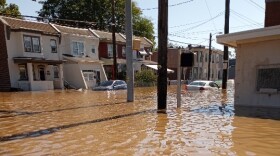FEMA rolls out a new pricing system for flood insurance designed to better reflect actual risk Friday. Many Delawareans will initially save money, while others will pay more.
The new National Flood Insurance Program (NFIP) pricing scheme called ‘Risk Rating 2.0’ incorporates more factors to determine a property’s risk from flooding. It's meant to increase equity by accounting for rebuilding costs.
More than a third of existing Delaware policyholders will see rates go down in the first year, according to data released by FEMA. More than half will see rates stay the same or increase by less than $120 a year, which the agency says is comparable to the average annual increase under the old rating system. But more than 10%—close to 2,800 policyholders—will see increases of more than $120 a year.
Several communities, including some on Delaware’s coast and in Wilmington, will see a greater portion of rates increase.
“I think Risk Rating 2.0 will send a better price signal about what it costs to live near the coast,” said Phil Barnes, a policy scientist at the University of Delaware’s Institute for Public Administration focused on climate resiliency.
Experts say the new pricing system could threaten home values. The new rates could eventually cause people to move away from flood-prone areas or cause developers to think twice about building there, Barnes says. He adds this could improve coastal resiliency in places like fast-growing Sussex County.
Even though her ZIP code will see more policies increase by over $120 annually than any other in the state, Bethany Beach Mayor Rosemary Hardiman says the numbers are not as bad as she feared.
“It’s true that there will probably be huge increases for some properties,” she said. “I have seen articles focused on those huge increases. … Naturally you start thinking, what’s going to happen? But when I saw the number of increases of $0-10 per month, which is $120 per year, and the far greater number of people affected by that, I didn’t think it was as great [an impact] as I was expecting.”
The numbers released by FEMA only reflect the first year of rate changes. The agency cannot raise homeowners’ rates more than 18% per year, and the New York Times reports the initial increases may reflect only a fraction of the eventual costs.
“Climate change is here,” Hardiman said. “You don’t know how things are going to affect the town over the years.”
Hardiman says Bethany Beach tries to keep flood insurance affordable by participating in FEMA’s Community Rating System, which rewards municipalities that pursue education and resiliency projects with discounts for residents.
Increasing equity
Several other municipalities in Delaware participate in the Community Rating System, but the City of Wilmington does not.
Around one in five households with NFIP policies in the Wilmington ZIP codes 19801 and 19802 will see rates rise by at least $120 a year under Risk Rating 2.0. This includes the Northeast neighborhood, which saw catastrophic flooding from the remnants of Hurricane Ida earlier this month.
FEMA admits that historically, policyholders with lower-valued homes paid more than their fair share of the risk, while policyholders with higher-valued homes paid less. The new system is expected to eliminate this inequity by accounting for the cost to rebuild a structure.
In the Wilmington ZIP codes 19801 and 19802, around 12% and 7% of single-family home policyholders respectively will see immediate rate decreases under Risk Rating 2.0. Barnes says he’s not surprised rate reductions are so limited in these areas.
“Of course, they assess higher value to higher-valued properties—you have a larger premium,” he said. “But the risk is what's being priced with Risk Rating 2.0. So I'm not surprised. Properties that are in riskier, more flood-prone areas could see increases in their flood insurance premiums.”
The State Department of Insurance is not directly involved with the Risk Rating 2.0 rollout, but supports the reduction in rates for some Delaware policyholders.
“The data that we have shows that our state will fare better than the national average under the new system,” said Christina Haas, senior advisor to Delaware’s Insurance Commissioner.
The new rates under Risk Rating 2.0 go into effect Oct. 1 for new policies. Existing policyholders whose rates are going down can get those savings the next time they renew. Increased rates for existing policyholders will go into effect after April 1.
Current NFIP policyholders can contact their insurance company or insurance agent to learn about their costs under Risk Rating 2.0.






